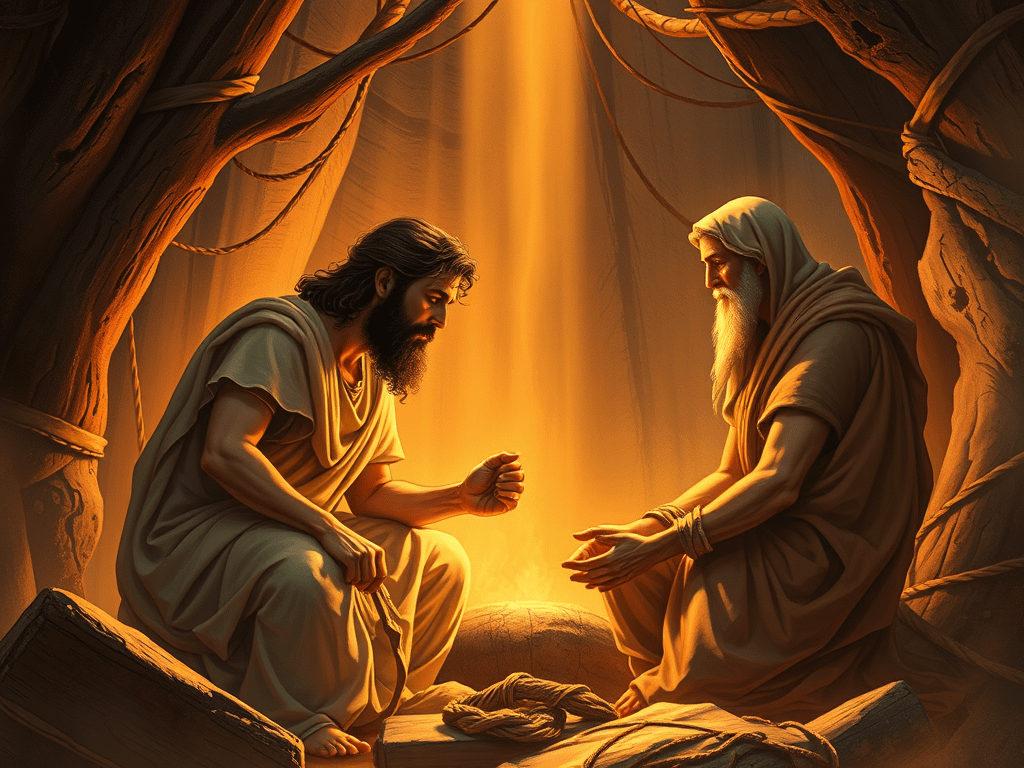Who was Lamech in the Bible?
Who was Lamech in the Bible? What would you do if you lived for hundreds of years? The tale of Lamech in the Bible, although brief, sparks curiosity as it intertwines themes of longevity, legacy, and moral complexity during a time of profound significance.
Though not as widely discussed as other Biblical figures, Lamech’s story illuminates intriguing facets of human nature and divine interaction during pre-flood times.
An Introduction to Lamech
Understanding Lamech requires delving into the context of his appearance in the Old Testament, specifically the Book of Genesis.
Lamech is a pivotal figure in biblical genealogy, linked both to the lineage of Seth, the righteous son of Adam and Eve, and to Cain, the first murderer.
Two men bearing his name appear in Genesis, each belonging to separate genealogical lines. This dual mention highlights differing life paths and the broader dichotomy between good and evil.
| Lamech’s Lineage | Notable Actions | Key Significance |
|---|---|---|
| Lamech from Cain’s line | Polygamous life, murder confession | Thematic representation of sin escalation |
| Lamech from Seth’s line | Father of Noah | Preservation of human righteousness |
The Line of Cain and Lamech
Within the genealogy of Cain, Lamech is introduced as a descendant who follows a morally questionable path.
His character is chronicled briefly in Genesis 4:17-24, where he becomes infamously known for taking two wives, Adah and Zillah, departing from the traditional monogamous relationships depicted earlier in scripture.
This act of polygamy may symbolize the degenerative effects of sin, as his ancestors had already deviated from God’s original intent for humanity. Furthermore, Lamech confesses to a violent act — killing a man for injuring him, which echoes and magnifies the sin of his forebear, Cain.
Another point of interest in his tale is the enigmatic “Song of the Sword,” where he justifies his actions with a boastful declaration of vengeance seventy-sevenfold.
This poetic passage underscores a biblical theme of escalating retribution and violence, providing insight into the pre-flood world where sin was rampant.
The Line of Seth and Righteous Lamech
In contrast, the Lamech of Seth’s genealogy is portrayed in Genesis 5, notably as the father of Noah.
This Lamech’s narrative, spanning only a few verses (Genesis 5:25-31), stands in stark contrast to his namesake of Cain’s line. Known for his long lifespan and prophetic utterance concerning his son, he symbolizes the continuation of righteousness despite the world’s corruption.
Lamech names his son Noah, expressing hope that Noah will bring “comfort from the toil and painful labor of our hands caused by the ground the Lord has cursed” (Genesis 5:29).
This expectation foreshadows Noah’s eventual role in God’s salvation plan through the Ark and the subsequent renewal of creation.
Herein lies a critical juxtaposition — while one Lamech embodies human failing, the other carries forth hope and continuity of divine blessing.
“If Cain is avenged sevenfold, truly Lamech seventy-sevenfold.” – A statement reflecting escalating moral corruption.
Interpretations and Symbolism in Lamech’s Story
Lamech’s dual appearances in Genesis offer readers a rich tapestry of symbolism and interpretation.
His story can be seen as a microcosm of humanity’s broader struggle between obedience and rebellion, each path offering different consequences and reflections on innate human tendencies.
The lineage of Cain with its spirals of sin and vengeance stands as a cautionary tale against straying from divine commandments. In contrast, Seth’s line, culminating in Noah, presents an allegory of redemption and divine covenant.
Both narratives together indicate a balance between justice and grace, themes recurrent throughout the Bible.
- Evident contrast in life choices underlines the free will concept and moral responsibility.
- The mention of polygamy and murder exemplifies human deviation from divine intention.
- The prophecy regarding Noah from the righteous Lamech showcases hope amid adversity.
- Interpreting Genesis stories aids in understanding human nature and divine hope.

The Cultural and Theological Impact of Lamech
The accounts of Lamech also offer substantial cultural and theological dialogue over time. Scholars and theologians often use these narratives to discuss ethical, social, and existential topics pertinent to the human condition.
The two Lamechs embody the perpetual struggle within communities and families, embodying themes like lineage, legacy, sin, and grace.
The divergence in their actions continually serves as a template for discussions on morality, illustrating that decisions made within familial lines impact generations.
Lamech’s Legacy Through Noah
Lamech of Seth’s lineage gains additional importance as the progenitor of Noah, a pivotal biblical character.
Noah’s story, marked by the building of the Ark and the survival of the flood, sets the stage for God’s covenant with humanity and represents continuity and rebirth.
Thus, Lamech’s faith and hopes find fulfillment through his son, linking his personal story to the broader narrative of human salvation.
Lessons Learned from Lamech’s Tale
The complexities of Lamech’s story in Genesis provide a valuable framework for understanding themes of hope, repentance, and divine justice.
Readers today can draw lessons about the importance of staying true to moral precepts, the potential ramifications of personal choices, and the abiding hope that redemption and renewal are always possible, reflecting the essence of divine love and mercy.
Conclusion
In conclusion, the narrative of Lamech in the Bible, with its dual genealogies, serves as a profound lens through which we can explore themes of morality, legacy, and divine intervention.
Whether as a cautionary tale or a beacon of hope, Lamech’s story resonates with timeless truths about human behavior and divine purpose, encouraging deeper reflection on the role each person plays within the grand narrative of life.
FAQ – Dúvidas Comuns
Who are the two Lamechs in the Bible?
The Bible refers to two different individuals named Lamech. One descends from Cain and is noted for his polygamous life and confession of murder, while the other descends from Seth and is known as the father of Noah.
Why is Lamech in Cain’s lineage important?
Lamech in Cain’s lineage is a key figure because his actions symbolize the ongoing deterioration of moral values, including the escalation of violence and vengeance.
What does Lamech’s prophecy about Noah indicate?
Lamech’s prophecy about Noah signifies a hope for relief and redemption from the cursed soil, foreshadowing Noah’s role in God’s salvation plan.
What can we learn from Lamech in the Bible?
The tales of Lamech offer insights into the human struggle between good and evil, the significance of legacy, and the constant possibility of redemption through divine grace.
How does Lamech’s story connect to broader biblical themes?
Lamech’s story connects to broader biblical themes like sin, justice, grace, and redemption, emphasizing the impact of personal decisions over generational sins and blessings.






